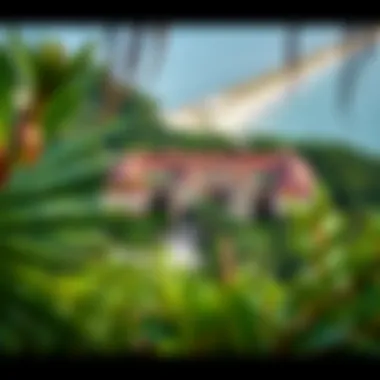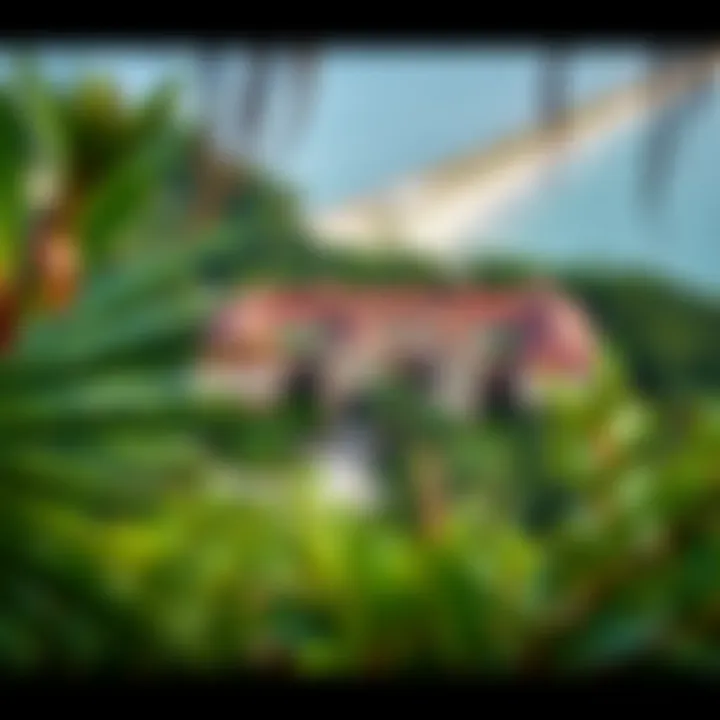Exploring the Rich History of Fort Clinch


Intro
Nestled at the northern tip of Amelia Island, Fort Clinch stands as a testament to both military ingenuity and the ever-changing tides of American history. This site vividly illustrates the dual narratives of conflict and preservation while celebrating the natural beauty that surrounds it. Construction began in 1847, with the fort designed to support the U.S. government's ambitions in the southeastern United States. It played a critical role during the Civil War and beyond, yet its importance transcends mere military history.
Today, Fort Clinch is not just a relic of the past but a vibrant state park that invites exploration and appreciation. Visitors can engage with the rich narratives of historical conflicts, the distinctive architecture, and the plentiful wildlife that makes the area an ecological gem. This article aims to unravel the layers of Fort Clinch's storied past, along with the cultural significance that continues to unfold. Each corner of the fort captures the essence of a time long gone, and as we delve into the details, it becomes evident that Fort Clinch is more than just stones and mortar; it is a vibrant piece of America's narrative tapestry.
Equipped with knowledge of its historical context, visitors can appreciate not only the fort's architectural features but also the recreational activities available in the area, which ranges from hiking to bird-watching. The flora and fauna present in the vicinity of Fort Clinch add another dimension to this compelling site, offering nature enthusiasts a chance to connect with the local ecosystem.
"Exploring Fort Clinch is like stepping into a living history book, where each brick has a story to tell and every path leads to a discovery."
In sum, Fort Clinch serves not only as a window into the past but also as a canvas for cultural narratives that resonate today. Whether you’re a history buff, an outdoor adventurer, or someone simply looking for a peaceful retreat, Fort Clinch presents an opportunity to engage with a unique blend of history, nature, and culture.
Historical Background
Understanding the historical background of Fort Clinch is crucial for grasping its significance within the broader narrative of American military history and local culture. Fort Clinch stands as a testament to the strategic military decisions that shaped the coastal defense system of the United States during turbulent times. Its rich legacy provides visitors an opportunity to engage with history, making it more than just an old fort; it's a doorway to the past, showcasing the evolving nature of warfare and community relations over the decades.
The Origins of Fort Clinch
Fort Clinch was born out of a need for comprehensive coastal defense when the U.S. government recognized the growing threats to its southeastern borders. Constructed in 1847, the fort was part of the Third System of Fortifications, a series developed after the War of 1812. The placement of Fort Clinch, on Amelia Island overlooking the St. Marys River, was strategic—not only did it command the surrounding waters, but it also provided a formidable defense against potential naval incursions. Constructed using tabby, a local concrete made from oyster shells, the fort is a notable example of antebellum fortification techniques. This technology was quite advanced for its time and highlights the ingenuity of the engineers who designed it.
Key Conflicts and Military Engagements
Throughout its active service, Fort Clinch saw its share of conflicts, playing key roles during the Civil War and later in smaller skirmishes with the local Indigenous populations. Initially occupied by Confederate forces during the Civil War, the fort changed hands when Union troops captured it in 1862. This strategic victory allowed the Union to secure control over coastal Florida, instrumental for blockading Confederate supplies.
The fort's function extended beyond mere military use; it served as a lookout during the Spanish–American War, representing the U.S.'s expanding influence and interests in foreign territories. The echoes of orders shouted and cannon fire still resonate within the fort’s walls, offering a glimpse into the turmoil and strategies of historical warfare.
Transition from Military in Active Service
With the dawn of the 20th century, Fort Clinch's military utility began to wane. The advent of more advanced warfare strategies and technologies rendered traditional coastal forts increasingly obsolete. By 1939, Fort Clinch was officially decommissioned, marking a significant transition in its role and purpose. Instead of soldiers patrolling its bastions, the area became an inviting natural space that offered recreational activities for adventurers and families alike.
In 1935, the fort was designated as a state park, ensuring its preservation for future generations. This transition highlights the evolving perception of historical landmarks—they transform from instruments of war to cherished sites of cultural and historical significance. The transformation of Fort Clinch embodies a wider narrative of how society values and preserves its heritage, shifting from militaristic functions to recreational and educational roles.
"Fort Clinch is not just a structure; it's a living artifact that tells the tales of resilience, strategy, and community through the ages."
As we dive deeper into the subsequent sections, let us not forget that Fort Clinch is more than historical markers and bricks; it's a narrative that connects past conflicts with contemporary dialogues about preservation, recreation, and community engagement.
Architectural Significance
The architectural significance of Fort Clinch extends far beyond aesthetics; it serves as a testament to the military strategies and cultural narratives of its time. This pervasive structure, constructed during the midpoint of the 19th century, embodies an intersection of artistry, engineering, and military thought that continues to attract attention from enthusiasts and historians alike. Fort Clinch isn't just a relic; it reflects the evolution of defensive architecture and stands as a symbol of American resilience. The design and structural ingenuity encapsulated in this fortification provide insight into its historical context and significance.
Design and Construction Techniques
When one observes the sturdy walls and the meticulous layout of Fort Clinch, it becomes evident that its design was forged in the crucible of necessity. Built between 1847 and 1867, the fort employed bastion geometry, allowing for maximum visibility and coverage of the surrounding landscapes. The primary materials used—brick and tabby concrete—exhibit durability and adaptability to coastal environments.


The construction techniques utilized reveal a blend of contemporary innovations and traditional methodologies. The builders relied on a template system for accuracy, ensuring that angles were consistent, and walls were true. This was a significant shift from earlier fortifications which often bore the irregularities of manual labor. The use of projectile-proof arched windows and thoughtful placement of artillery platforms indicates a foresight into the evolving nature of warfare.
Defensive Structures and Innovations
In the realm of fortifications, Fort Clinch was not just a hardened shell; it was a veritable fortress brimming with defensive capabilities. The design included glacis—an angled earth slope—which helped ricochet incoming projectiles away from the walls. This aspect was paramount during its operational years, making it a more resilient structure against artillery fire than many of its contemporaries.
Furthermore, the incorporation of deep ditches and floodable moats served to deter would-be attackers, illustrating a comprehensive understanding of tactical defenses. The casemates, or defended gun emplacements, further showcase military ingenuity, allowing artillery to be safely positioned while providing maximum fire coverage.
��“Fort Clinch is more than just an old building. It’s a narrative of defense, design, and duty—a living testament to the challenges faced in its era.”
Restoration and Preservation Efforts
As time marches on, preserving the architectural integrity of Fort Clinch becomes both a challenge and an obligation. Restoration efforts have taken great care to maintain the authenticity of the structure, honoring its original design while adapting to modern conservation practices. The Florida State Parks and various historical societies engage in ongoing programs aimed at retaining the fort's character against the elements of time.
The most notable restoration efforts focus on the ever-fragile mortar joints and faux finishes that characterize the fort's exteriors. Over the years, not only has there been a focus on structural stability, but also on creating informative signage and contexts to educate visitors about its rich history. Working alongside conservation scientists, historians aim to ensure that every brick laid remains as it was intended, capturing the essence of its epoch.
Through these initiatives, Fort Clinch has managed not only to preserve its identity but also remains a vibrant cultural site for modern visitors, marrying history with contemporary understanding. The significance of its architecture, thus, is not solely in its physical state but in its ability to foster education, appreciation, and reflection on America’s military past.
Ecological Context
When one considers Fort Clinch, it’s easy to get lost in the tales of military prowess and architectural intricacies. Yet, the ecological context surrounding this significant historical site is equally vital. Not only does it provide essential habitat for a range of species, but it also plays a pivotal role in maintaining coastal health. In this section, we'll unpack the various dimensions of Fort Clinch's ecological surroundings, from the coastal ecosystems that thrive nearby to the unique flora and fauna that call this area home.
The Importance of Coastal Ecosystems
Coastal ecosystems are the lifeblood of many regions, serving as an intricate tapestry of life that supports numerous species. For Fort Clinch, its proximity to the Atlantic Ocean creates a rich environment teeming with biodiversity. Coastal ecosystems, such as salt marshes and tidal flats, are instrumental in promoting water quality and providing shelter and breeding grounds for various marine organisms.
- Habitat for Wildlife: These areas offer refuge for birds, fish, and other animals, especially during migratory seasons. Birdwatchers might find roseate spoonbills and great egrets courting their landscapes, adding to the visual symphony of the area.
- Natural Buffers: They act as natural barriers against storm surges and erosion, safeguarding not only the ecosystems but also historical structures like Fort Clinch itself.
- Economic Benefits: Healthy coastal ecosystems contribute to local economies through tourism and fisheries, supporting endeavors from kiteboarding to fishing excursions.
Flora and Fauna Indigenous to the Area
The landscapes around Fort Clinch boast an array of unique plant and animal species. The salt marsh grasses, such as Spartina alterniflora, are ideally suited for the brackish waters, while the surrounding uplands host a more diverse range of flora. This juxtaposition of ecosystems offers a rich field of study for ecology enthusiasts.
Among the noteworthy wildlife, one can spot:
- Eastern Box Turtles: Often seen sunbathing on logs, these elusive reptiles make their homes in sandy soil and prefer humid environments.
- Gopher Tortoises: An important keystone species, they dig burrows that serve as shelters for up to 360 other species, thus enhancing local biodiversity.
- Osprey: Seen soaring overhead, these magnificent birds are crucial indicators of the ecosystem's health, feeding primarily on fish from coastal waters.
By nurturing habitats that cater to both terrestrial and aquatic life, the Fort Clinch area stands as a veritable haven for biodiversity.
Environmental Challenges and Conservation
Despite its rich ecological backdrop, Fort Clinch faces considerable environmental challenges. Factors such as climate change, pollution, and urban development threaten the delicate balance of its coastal ecosystems. Rising sea levels, for instance, pose a significant risk to both the fort and its surroundings, emphasizing the need for informed conservation efforts.
- Climate Change Impact: Increased flooding and salinity can degrade quality habitats and force species to adapt or migrate, disrupting the local ecological fabric.
- Pollution: Runoff from urban areas may introduce harmful chemicals into local waterways, creating a paradox of human development impacting nature.
- Conservation Efforts: Thankfully, various stakeholders, including state parks and conservation organizations, are mobilizing to safeguard this vital area. Initiatives range from habitat restoration projects to education programs aimed at raising public awareness of ecological importance.
"Conservation is a state of harmony between men and land." — Aldo Leopold


As we continue to explore Fort Clinch, it becomes clear that recognizing and nurturing its ecological context is not just an obligation but a necessity for ensuring its future, both as a site of historical importance and as a vital part of the local ecosystem. Efforts to maintain harmony between nature and history will go a long way in preserving the integrity of Fort Clinch for generations to come.
Recreational Opportunities
Exploring Fort Clinch isn’t just about soaking in the history or architecture; it’s also a gateway to numerous recreational activities that allow visitors to engage with nature and enjoy the scenic beauty this historic site offers. The blend of coastal waters and wooded areas provides an array of possibilities for adventurers, families, and nature enthusiasts alike. It’s a chance to not only unwind but to also embrace the rich biodiversity surrounding the fort, making it an essential aspect of any visit.
Kiteboarding and Water Sports
Kiteboarding at Fort Clinch is a standout experience, attracting thrill-seekers looking to harness the wind and waves. The adjacent waters of the Atlantic offer ideal conditions for kiteboarders, thanks to a mix of steady winds and expansive beaches. This area isn’t just a random good spot; it’s a well-known destination where both novices and seasoned kiteboarders gather to ride the swells. As they slice through the water, tourists can often be seen exchanging tips, their vibrant kites painting the sky. Safety considerations, like checking local wind conditions and understanding tides, can enhance the kiteboarding experience.
Hiking and Nature Trails
Hiking at Fort Clinch is like stepping into nature’s own gallery. The fort is surrounded by a network of trails that meander through lush landscapes, offering breathtaking views of the coastal ecosystem. Wildflowers bloom in a dazzling array of colors during spring, while shady oak canopies provide respite from the heat in summer. Each trail showcases a different facet of the area, from salt marshes to maritime forests. Additionally, local wildlife often makes appearances, providing unexpected moments for photographers and nature lovers. Before heading out, mapping your route and considering the difficulty levels of each trail can be advantageous.
Camping and Picnicking Facilities
For those who want to linger longer, Fort Clinch offers well-equipped camping facilities suitable for families and solo travelers. Setting up a tent under the stars allows visitors to soak in the night sky, which can be a breathtaking sight without the interference of city lights. Picnic areas strategically placed throughout the park create opportunities for relaxation and recharging. Families can enjoy lunch surrounded by the sounds of nature, creating perfect memories while indulging in delightful meals brought from home or local eateries. Reservations for campsites during peak season are a wise move to ensure a spot.
Recreation at Fort Clinch goes beyond mere leisure; it’s about immersing oneself in nature, becoming part of a community, and relishing activities that celebrate this beautiful coastal landscape.
In summary, Fort Clinch is more than just a historical landmark; it is a vibrant hub for recreational activities that connect visitors to the natural world. Whether you’re water sports-minded, a hiker, or someone who appreciates a good picnic, Fort Clinch caters to all interests. With each visit, you embrace a different aspect of this rich environment, ensuring that there's always something new to explore.
Cultural Narratives
Cultural narratives are a window into the values, beliefs, and experiences of both individuals and communities associated with a place. At Fort Clinch, these narratives are layered and multifaceted, representing the diverse stories of soldiers who once defended the fort, civilians who lived nearby, and the broader community's evolving perception of its historical significance. By exploring these narratives, one can appreciate how Fort Clinch not only serves as a symbol of military history but also as a canvas for human interaction across generations.
Stories of Soldiers and Civilians
The tales of soldiers stationed at Fort Clinch brim with courage and camaraderie, punctuated by the realities of military life in the 19th century. Soldiers endured rigorous training and long hours of duty, often under harsh conditions. Yet, amidst the strict regimens, they formed friendships that often lasted a lifetime. These relationships are not just historical footnotes; they remind us that behind every uniform was a person with dreams and fears.
Civilians, too, wove their lives into the fabric of Fort Clinch. Families relying on nearby resources crafted their narratives while living in the shadow of the fort, creating a unique blend of military and civilian life. They are stories of local folklore, passed down from grandparents to grandchildren, echoing laughter and hardship alike. The accounts of picnics by the shore, the sounds of distant cannon fires during drills, and the thrill of watching soldiers march instill a deep sense of belonging to the area.
Historical Interpretations and Tourism
When it comes to historical interpretation, Fort Clinch reveals a tapestry of meanings and perspectives. As tourists flock to the fort, they engage with stories that are often shaped by current societal values and interests. This ongoing dialogue between the past and present influences how the fort is portrayed in brochures, museum exhibits, and even local folklore. The interpretation of history here is not static; it evolves with time, responding to new generations’ curiosity and changing attitudes.
Tourism around Fort Clinch has increased significantly over the years, serving as a catalyst for greater public interest in its history. Visitors are drawn by the promise of adventure, seeking to connect with both the historical military significance and the serene beauty of the surrounding landscape. Guided tours offer insights into daily life during military times, along with the fort’s role in conflicts. These tours transform a simple visit into an immersive experience, enriching understanding and appreciation of the site’s cultural importance.
Art and Literature Inspired by Fort Clinch
Art and literature often capture the essence of a place in ways that standard historical records cannot. Fort Clinch has inspired a range of artistic expressions, as writers and artists delve into its storied past. From poignant poetry reflecting the soldier's journey to paintings and photographs that immortalize its rugged beauty, the fort serves as a muse for many.
Local artists frequently showcase their interpretations through galleries and exhibitions, offering fresh insights into Fort Clinch’s impact on the community. Likewise, authors find rich narratives in its walls, creating fictional stories set against the backdrop of historical events. These creative works contribute to a renaissance of cultural appreciation, inviting people to engage with Fort Clinch not just as a tourist destination but as a living, breathing story that continues to unfold.
In summary, cultural narratives at Fort Clinch are essential in understanding its comprehensive significance. They weave together the myths and realities of both soldiers and civilians, influencing historical interpretations and inspiring creative endeavors. This narrative interplay not only enhances the visitor experience but also enriches the broader understanding of this iconic location, ensuring its stories are not forgotten.


Visitor Information
Visitor information serves as a vital component to fully appreciate the intricate tapestry that Fort Clinch represents. An understanding of how to access this historical site, the guided experiences available, and the optimal times to visit can vastly enhance one’s experience. For anyone from kiteboarders seeking a new adventure to travelers curious about America’s past, having detailed visitor information is paramount.
Access and Transportation
Getting to Fort Clinch isn’t rocket science, but knowing your options can sure make life easier. Located on Amelia Island in Florida, the fort is conveniently placed for those traveling by car. The nearest major travel hub is Jacksonville International Airport, situated roughly 30 miles away. From there, a quick highway drive leads directly to the island.
Local streets wind through quaint neighborhoods, offering glimpses of coastal life along the way. For those who might prefer public transportation, it's a bit trickier. Buses run from Jacksonville, but options can be limited, and it might require some additional planning. It’s worth reaching out ahead to ensure a smooth trip.
Additionally, parking is plentiful at the state park. A small fee is charged, so be sure to bring some cash or a card.
Guided Tours and Interpretation Programs
Navigating through history can sometimes feel overwhelming, but guided tours at Fort Clinch make it an easier task. These tours often include enthusiastic park rangers who bring the past to life through engaging storytelling. They weave tales of soldiers, battles, and everyday life during the fort's operational days. It’s like stepping back in time without the musty smell of history!
Many guided tours are designed to accommodate different interests. For instance, one can focus on the military aspects, while others may delve deeper into architectural features or the surrounding ecosystem. There are also interpretation programs that highlight specific events or themes—perfect for families or school groups wanting a deeper understanding.
Best Times to Visit
Timing can be everything when it comes to enjoying Fort Clinch. Weather-wise, Florida tends to get quite hot in summer, making it less appealing unless you enjoy sweat dripping down your back. The best months to visit are generally October to April when temperatures are milder, making hikes and outdoor activities far more enjoyable.
Here are a few things to consider when planning your trip:
- Fall and Spring: Ideal for both comfort and fewer crowds. Nature trails and beach access are particularly enjoyable during these months.
- Winter: While still pleasant, it can get cooler. This is actually a great time for kiteboarding if wind conditions cooperate and the air is fresh.
- Events: Keep an eye on the Fort Clinch schedule for special events such as reenactments or educational programs. These can provide unique insights and enhance the overall experience.
In summary, knowing how to reach the fort, understanding the array of tours available, and picking the right time for your visit can make all the difference.
"The stories of Fort Clinch do not just lie in its walls, but also unfold in the experiences of those who venture here."
Plan your trip well, and you might just walk away with a treasure trove of memories and knowledge.
Culmination
The essence of Fort Clinch transcends its brick and mortar; it is a monument bearing witness to the trials and triumphs of American history. The exploration in this article not only underscores the fort’s pivotal roles in military engagements but also elevates our understanding of its architectural prowess and ecological surroundings. Visitors and history buffs alike are drawn to this location, appreciating its layered narratives that echo the sacrifices of those who served.
Reflecting on Fort Clinch's Legacy
Fort Clinch stands as a tangible reminder of the past, where each stone tells a story of conflict, community, and change. This historical landmark has transitioned from a key military stronghold to a beloved state park, showcasing resilience against the test of time. The fort's legacy manifests in the memories it fosters, connecting generations through guided tours, reenactments, and educational programs. As tourists walk its grounds, they might feel a sense of solemnity or inspiration, feeling connected to the lives and legacies etched into its walls. Fort Clinch is not just a site of history; it's a repository of shared human experiences.
The Role of Fort Clinch in Education and Research
The educational aspect of Fort Clinch cannot be overstated. It serves as a live classroom, where students and adults alike can immerse themselves in interactive learning environments. Various programs are organized, ranging from school trips to historical reenactments, making this heritage site a critical resource for educators. The fort also plays a role in academic research, as scholars delve into its history, scrutinizing archives and artifacts that reflect military architecture and coastal defense evolution. The fort embodies an intersection of disciplines, enticing historians and ecologists who examine its environmental impact and adaptive reuse.
Future Prospects for Preservation
As times change, so do the challenges associated with preserving historical sites like Fort Clinch. The increasing threats from climate change and coastal erosion necessitate proactive measures to ensure this landmark endures for future generations. Ongoing restoration projects focus on maintaining the integrity of the structures, while new initiatives strive to enhance visitor engagement without compromising historical authenticity. Collaboration among government entities, local communities, and conservationists will be crucial. Investing in educational and preservation programs can fortify Fort Clinch's place in the cultural landscape, ensuring that its significance is recognized and cherished well into the future.
"Preservation serves as a bridge between our nation's past and future; it is a commitment to those who came before us and those who will come after."
Fort Clinch, with its rich tapestry of history, architecture, and ecology, remains a vital part of the American narrative, and understanding its legacy, educational potential, and future is essential for nurturing this historical treasure.















